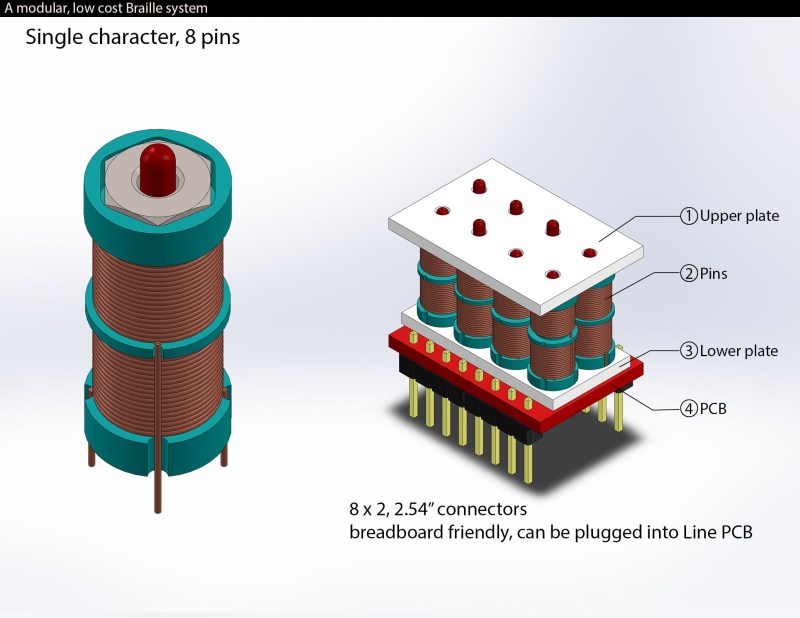A lot of work with binary arithmetic was pioneered in the mid-1800s. Boolean algebra was developed by George Boole, but a less obvious binary invention was created at this time: the Braille writing system. Using a system of raised dots (essentially 1s and 0s), visually impaired people have been able to read using their sense of touch. In the modern age of fast information, however, it’s a little more difficult. A number of people have been working on refreshable Braille displays, including [Madaeon] who has created a modular refreshable Braille display.
The idea is to recreate the Braille cell with a set of tiny solenoids. The cell is a set of dots, each of which can be raised or lowered in a particular arrangement to represent a letter or other symbol. With a set of solenoids, this can be accomplished rather rapidly. [Madaeon] has already prototyped these miniscule controllable dots using the latest 3D printing and laser cutting methods and is about ready to put together his first full Braille character.
While this isn’t quite ready for a full-scale display yet, the fundamentals look like a solid foundation for building one. This is all hot on the heels of perhaps the most civilized patent disagreement in history regarding a Braille display that’s similar. Hopefully all the discussion and hacking of Braille displays will bring the cost down enough that anyone who needs one will easily be able to obtain and use one.



















Just a thought – what about tiny piezo disks driven with lower frequencies that cause haptic sensation.
Many *many* years ago (like 35, perhaps) I saw the idea of vibrating Braille dots (they were electromagnetic back then).
So at least the principle seems viable.
That’s the traditional way of doing it… problem is that to get sufficient movement that it can be easily felt, you need around 70V, which you have to keep well away from the users fingers, which is why they are not cheap.
what is the current? Voltage is only part of the equation.
Most Tazers are in the hundreds of thousands of volts, and are, mostly, Human safe.
The 70 volts issue isn’t about safety; it’s probably difficult to read braille while your fingertips are buzzing.
*buzzing because of accidental contact of 70 volts.
Tingling probably would have been a better word. ;)
Nice project, the problem is easy. Create a pin that goes up and down. The design restrictions make it very difficult. Because you need a lot of these devices to create a useful product, so it must be small, energy efficient, require simple/small driving electronics, perhaps noise could be an issue. And last but not least, it must last forever, because the user will not immediately notice it if there is a problem.
I wonder if people who are reading this are realizing these problems.
I hope you succeed in this project, it could help so many people.
Question … Is it a display?, is it text?, is it a feel?
That’s probably a very valid point but [Bryan Cockfield] may just have to take that one on the chin as he can’t really change the article title.
Texture?
Display is defensible since in theory a sighted person could read the dots without feeling them, their general low contrast makes this hard to do though.
Yes. :’)
(They are actually called “refreshable Braille displays” traditionally.)
This is a great project, I wish them best of luck. If the final BOM is cheap enough, people could build one even without the need driven by visual impairment, i.e. just for fun. Commercial RFDs are too expensive for hackers, though subsidies exist for some with disabilities.
My grandfather had significant visual impairment. I regret not learning Braille while it was readily available to me. I’d build one for that reason alone.
Imagine having one of these in your pocket, on your sleeve cuff or along the edge of your phone. You could read anything covertly.
Your idea of embedding into a phone got me to think of using the phone’s vibrator to pulse out morse code. There’s already an app for it.
I don’t understand why there are 2 coils. My intuition would be to have one coil and reverse the polarity of the current to go up or down. What am I missing?
I was wondering the same thing.
Maybe it was easier for the prototype, or it helps hold the pins’ position when a finger is placed upon them.
Maybe the code drives them like a stepper motor; I haven’t examined the video or the IO page yet though.
Easier to do than using an h bridge? Based on their stacking, I’m guessing they are both in “pull” mode to a single ferrous core – you’d need a magnet at the base of each pin for a push/pull.
what about printer heads form old epson ribbon printers?
i remember some old epson ribbon printers, you should try look for some old printer head
How does it stop the user from accidentally pressing the pin in?
If its adequately designed and spaced, with teh bottom coil repulsing the pin, it should just pop right back up (and would give some feedback resistance to being pushed down)
would be cool to get the feedback from the pin being pushed down against the force of the electromagnet (perhaps this would cause a change in the voltage as it is pressed down) rendering it into a braille push button!
other interesting approach..
https://www.facebook.com/plugins/video.php?href=https%3A%2F%2Fwww.facebook.com%2FVocativVideo%2Fvideos%2F603192999840524%2F